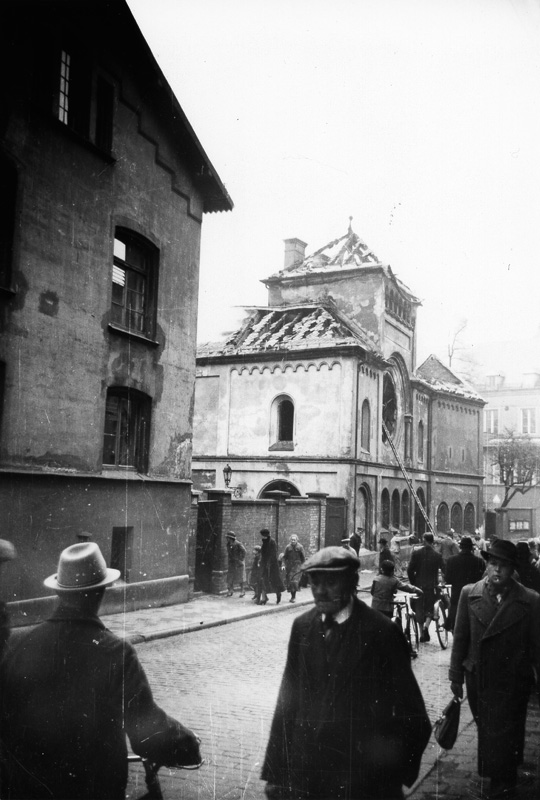Die innerjüdischen, zum Teil heftig geführten religiösen Auseinandersetzungen um Reform und Tradition hatten im 19. Jahrhundert zu einer Spaltung zwischen liberalen und orthodoxen Juden auch in München geführt, die sich u.a. im Synagogenbau widerspiegelte. Anlass für die Spaltung war der Streit über die Einführung einer Orgel im Gottesdienst gewesen, die von der orthodoxen Minderheit der Gemeinde abgelehnt wurde und schon 1870 zum Rücktritt des Vorstandes geführt hatte. Da ab 1876 die Orgel in der damaligen Synagoge im Gottesdienst verwendet wurde, bildeten die Orthodoxen eigene Vereine und organisierten Gottesdienste in Betstuben nach herkömmlichem Ritus. Bethäuser waren in der Fürstenfelder Straße 13, der Hartmannstraße 3, in der Gaststätte Hundskugel und an der Kanalstraße 29 (später Herzog-Rudolf-Straße 11). Das Bethaus an der Kanalstraße entwickelte sich zum Gründungsort der späteren Synagoge Ohel Jakob. Dort war 1874 im Parterre und im ersten Stock eine Betstube eröffnet worden, die sich aufgrund eines Umbaus ab 1879 im ersten und zweiten Stock befand. 1887 beantragten Angehörige der Orthodoxie bei der Israelitische Kultusgemeinde den Neubau einer eigenen Synagoge, was diese aber ablehnte und stattdessen die Anmietung eines Betsaales in dem entstehenden Gemeindehaus in der Herzog-Max-Straße vorschlug. Doch der Plan zerschlug sich.
Nach der Eröffnung der von den Glaubensliberalen dominierten Hauptsynagoge 1887 beantragte die orthodoxe Gemeinde bei der Lokalbaukommission der Stadt München einen Neubau in der Kanalstraße 24 (ab 1903: Herzog-Rudolf-Straße 3). Der von Angehörigen der Betstube gegründete Verein zur Förderung der jüdischen Wissenschaft, Ohel Jakob (Zelt Jakobs) genannt, erwarb ein Grundstück, auf dem die Synagoge dann in den Jahren 1891/92 im damals für derartige Gebäude populären neoromanischen Stil nach Plänen des Architekten August Exter errichtet wurde. Das Nachbargrundstück beherbergte ab 1924 eine israelitische Schule.
Tatsächlich war die Situation für die orthodoxe Gemeinde nicht einfach, denn das bayerische Judenedikt von 1813 erlaubte für jeden Ort nur eine einzige israelitische Kultusgemeinde. Die separaten Gottesdienste der Orthodoxen mussten deshalb von der liberalen Münchner Kultusgemeinde genehmigt werden. Doch die Zuwanderung von Juden*Jüdinnen aus Osteuropa stärkte die Orthodoxen. 1907 einigten sich die Israelitische Kultusgemeinde und der Verein Ohel Jakob, dass letzterer seine eigene Gottesdienstordnung beibehalten durfte und zwei Prozent der Kultusbeiträge erhielt. Die religiöse Oberaufsicht blieb zwar beim Hauptrabbiner der Gemeinde, der sie aber an den orthodoxen Rabbinatsassessor, den 1885 berufenen Rabbiner und Talmudgelehrten Heinrich Ehrentreu abgab. Mit der Weimarer Verfassung entfiel der Zwang zur Einheitsgemeinde. 1922 wurde wieder eine Vereinbarung zwischen der Israelitischen Kultusgemeinde und dem Verein Ohel Jakob geschlossen, der den Orthodoxen noch weitergehende Rechte einräumte.
Die aus Osteuropa stammenden Juden*Jüdinnen, die in München eine neue Heimat gefunden hatten, spalteten sich ihrerseits von Ohel Jakob ab und schufen sich 1931 eine eigene Synagoge in einem Hinterhof in der Reichenbachstraße. Beim Pogrom im November 1938 wurde die Inneneinrichtung der Synagoge Ohel Jakob in der Herzog-Rudolf-Straße demoliert und das Gebäude in Brand gesetzt. Der Brand vernichtete die Ritualgegenstände vollständig, obwohl Rabbiner Ernst Ehrentreu (Sohn von Heinrich Ehrentreu) versuchte, die Thorarollen zu retten. Er kam nach dem Pogrom, wie viele männliche Gemeindeangehörige, ins KZ Dachau. Ebenso wurde die jüdische Volksschule demoliert. Der Unterricht konnte erst im Januar 1939 in einem anderen Gebäudeteil fortgesetzt werden. Die Gebäudereste der Synagoge Ohel Jakob wurden auf Anordnung der Münchner Lokalbaukommission im März 1939 abgerissen und entfernt. In den 1950er Jahren wurde das Grundstück erneut bebaut. Heute erinnert eine Gedenktafel an die Synagoge.


